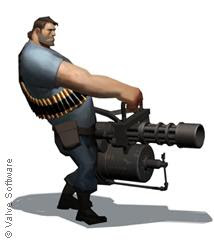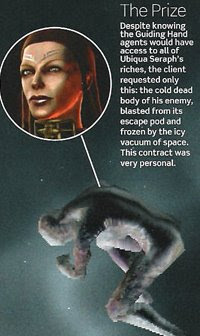Sunday Reading
December is a busy time of year. Busy cramming for the exams next week? Caught up in the holiday rush? Either way, you're probably online looking for an excuse to procrastinate for another hour or so. Here's some recommended reading to help you do just that.
First up is an article over at CGSociety about the visual design of Team Fortress 2. I've geeked out more than once about how much I love this particular aspect of the game, but reading this article has given me a new found respect for the team of animators at Valve. Among the piles of great concept art (including an early build of the Heavy with a mullet), the article explores how well-designed characters and maps can enhance the gameplay experience. Consider the following excerpt:

Due to the importance of the nine character classes to the gameplay, the team focused on them first. They established a "read hierarchy", a prioritized list of the information that players needed to extract from the character model. From most to least important, this was: the player's team, the player's class, and the player's current weapon, which usually implies the player's intent in our game.
They used the model color palette to represent the team, a somewhat suboptimal solution for varying lighting conditions, but a good tradeoff given the technology constraints. “We found that silhouette and animation were better long-range identification characteristics than texture detail or color,” says Jamaal Bradley, “so we used those for class identification. Finally, we tackled the weapon by using contrast and color gradients to draw the player's eye to the chest area, where the weapons are held.
What a powerfully simple idea: using colour, shading and silhouettes to draw the player's eye towards important information. It's this level of attention to detail that has garnered Valve so much critical acclaim and fan loyalty. For more TF2 reading, consider the recently released Steam statistics, which include heatmaps and other interesting tidbits (such as the fact that the Medic class is criminally underplayed.)
Secondly is a fascinating look at the Morris worm, a 99 line program that ended up infecting 10% of the Internet back in 1988. The creator, Robert T. Morris, was a grad student working at Cornell University who simply wanted to prove that it was possible to propagate a program by exploiting vulnerabilities in sendmail and Finger. However, due to a flaw in the reproduction algorithm, the benign worm ended up reproducing itself many times on the same computer, eventually tying up the CPU. While the Morris Worm has been overshadowed by some of the modern malignant worms, I highly recommend this article to anyone involved in software security as a case study from a time when the web was much more homogeneous.

Finally, a short article about one of the most famous and successful heists in MMORPG history, one that left the victim's character frozen dead in space and relieved of virtual goods worth an estimated $16,500 USD. It's a fascinating look into the world of EVE Online, a game that seems to be as much about political intrigue and skulduggery as it is about spaceships and mining. The story reads like a virtual Ocean's Eleven, and is an interesting commentary on the consequences of meeting people semi-anonymously in online worlds.
Have a great weekend, and best of luck in all your procrastinating.
Labels: Gaming Industry, Programming, Video Games


0 Comments:
Post a Comment
Subscribe to Post Comments [Atom]
<< Home